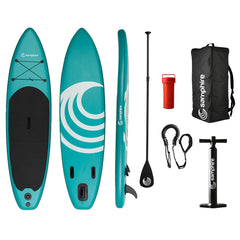
How To Choose A Paddle For Your SUP
WHERE TO BEGIN?
You can have the best board out there, but without a good paddle you can actually make your life much harder.
To find the correct SUP paddle for you, consider these points:
CHOOSING THE CORRECT LENGTH
A paddle too long will be tough to use, but one that’s too short will require you to put yourself in awkward and uncomfortable positions.
E.G. For touring:
Step 1: Stand the paddle upright with the blade touching the ground
Step 2: Reach one of your arms up vertically and note where it lands on the paddle
Step 3: The correct sized paddle will mean that the T-grip handle will fall in the bend of your wrist (if you are able to adjust the paddle, adjust to this height)
Step 4: If ordering online, add 8 to 12 inches to your height and then choose the paddle of this length
NOTE: for other activities such as surfing/ racing you will require a different length of paddle. SUP racers typically choose a paddle which is slightly longer than the touring length, whilst SUP surfers choose paddles which are slightly shorter.
CHOOSING THE CORRECT MATERIALS
The materials used for the paddle will determine its weight and stiffness. When determining which material you would like your paddle to be made from consider these factors:
- Do I need a light paddle? For long tours or racing, yes. If only for occasional outings, then not really.
- Do I want a stiff paddle? Stiff paddles can place tensions on your muscles and joints so if you have any previous wrist, arm or shoulder injuries you may want to choose a paddle with some flexibility
- How much do I want to spend? Lightweight materials such as carbon fibre, are more expensive than heavier ones such as plastic and aluminum.
Here are the most common materials used for paddles:
Carbon fibre - This is the lightest and most stiff material, which often means it is the most expensive option. However, it is worth the money if you’re a frequent long-distance paddler due to the excellent power delivered from your muscles to the blade.
Fiberglass - Another excellent lightweight choice. This material is used for the shaft and/or blade. Fiberglass is still stiff but less so than carbon fibre, making it more affordable.
Plastic - Used for entry-level paddles, plastic is affordable and durable and is almost always paired with an aluminium shaft.
Aluminium - This is often used in the shaft of SUP paddles, as it is affordable and lightweight. However, it is not as light or stiff as carbon fibre or fiberglass. An aluminium shaft is often paired with a plastic blade, which makes it great for beginners.
Wood - Some paddles are made entirely from wood. Although beautiful, they can often be heavier and more expensive than the other materials.
CHOOSING THE BLADE SIZE
If you’re brand new to SUP, use this guideline: The larger you are, the larger your blade can be. This is down to the fact that bigger paddlers typically have the strength to pull a larger blade through the water.
However blade size is largely based on preference and you may find the more you use your SUP you develop preferences for different sizes.
CHOOSING YOUR BLADE SHAPE & OFFSET
As you can imagine, the shape of your blade affects how it moves through the water. The 2 main shapes are:

Tear-drop: This shape has its widest point at the bottom, meaning that as soon as the blade is in the water, you are immediately pushing water with the majority of the blade's surface area. Therefore a powerful stroke, which is preferred by SUP surfers.
Rectangular: These blades are narrower at the bottom compared to a tear-drop blade, resulting in a smaller surface area when the blade hits the water. This creates a more gentle stroke and can be easier on your muscles / joints.
Now we look at the offset of the blade.

The offset of the paddle is the degree to which the blade angles itself forward from the shaft. The size of this angle affects how vertical the blade will be when travelling through the water, which affects the amount of power needed for every stroke.
Below are some general offset recommendations:
SUP Racing - approx. 12 degrees
Mixed Use - approx. 10 degrees
SUP Surfing - approx. 7 degrees
We hope this has helped you determine the type of paddle you will need for your SUP, but if you still feel like you need more help, please contact us at support@sup-warehouse.com or visit our social media pages and reach out to us!



